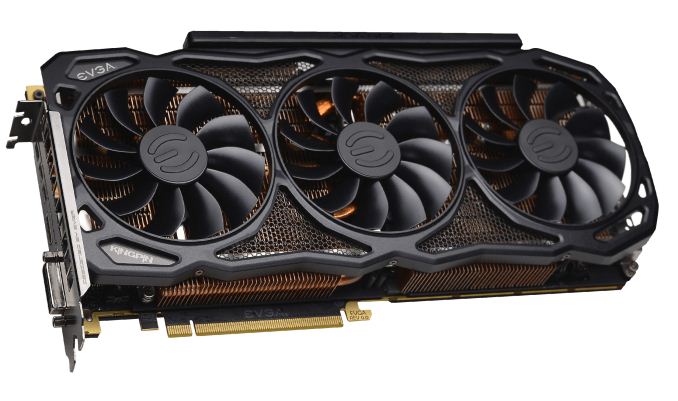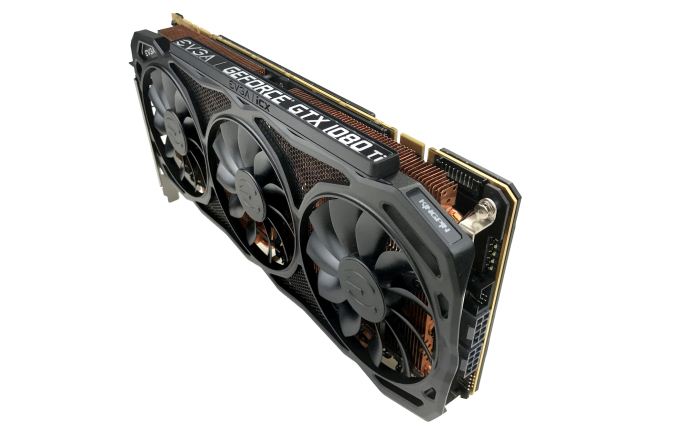EVGA Unveils its GeForce GTX 1080 Ti K|NGP|N Edition
by Ryan Smith on May 31, 2017 11:00 AM EST- Posted in
- GPUs
- EVGA
- Pascal
- Computex 2017

EVGA has once again collaborated with extreme overclocker Vince "K|NGP|N" Lucido to develop the new EVGA GeForce GTX 1080 Ti K|NGP|N Edition. As EVGA’s ultra-high-end overclocking card, EVGA is guaranteeing each card can be overclocked to at least 2025MHz, which means we’re looking at a binned card with a whole heap of modifications and tweaks to allow for squeezing the last few MHz out of the card.
| EVGA GeForce GTX 1080 Ti K|NGP|N Edition | |||
| Boost Clock | 2025MHz | ||
| Memory Clock | 11Gbps | ||
| VRAM | 11GB | ||
| TDP | Well Over 250W If You're Doing It Right | ||
| Power Connectors | 2x 8pin | ||
| Length | ? | ||
| Width | 2 Slot | ||
| Cooler Type | Open Air | ||
| Price | TBD | ||
EVGA uses a fully custom PCB designed to withstand the rigors of overclocking. The card features a 15 phase digital VRM system with dual 8-pin power connectors on the right edge for better cable management. You will also find the EVGA Evbot connector next to the power connectors on the rear of the card, an interesting situation as this is a feature that doesn’t show up on too many EVGA products these days. The PCB features nine temperature sensors: three for memory, five for PWM, and one for the GPU. When it comes to display connectivity, there are three Mini DisplayPort 1.4 connectors, one DVI, and a single HDMI 2.0 port all in a row, making it possible to create a single-slot graphics card when used with a water block.
The heatsink shroud has a very similar look to EVGA's FTW3 edition video card. Integrated into the black plastic shroud you’ll find three large dual-ball bearing fans pushing air through interlaced copper-plated fins bonded to six copper heatpipes (three 6mm and three 8mm) that are attached to the copper-plated baseplate. A large metal backplate spans the entire length of the graphics card, adding rigidity and structural strength to prevent it from bending under the weight of the heatsink. The card also has accommodations for LN2 overclocking.
EVGA's Jacob Freeman tweeted a picture from Computex showing the GTX 1080 Ti K|NGP|N Edition running cool as a cucumber at 2404MHz. The company said the card will be available in July. No price has been announced yet.
Steven Lynch Contributed to this Report
Source: EVGA











21 Comments
View All Comments
Memo.Ray - Wednesday, May 31, 2017 - link
"card can be to be overclocked"jimjamjamie - Thursday, June 1, 2017 - link
they don't think it be like it is, but it do.DanNeely - Wednesday, May 31, 2017 - link
"When it comes to display connectivity, there are three Mini DisplayPort 1.4 connectors, one DVI, and a single HDMI 2.0 port all in a row, making it possible to create a single-slot graphics card when used with a water block."It looks like the exterior bracket is a single piece. Unless I'm not seeing something (possible due to the oblique angle o the image); to do it as a single slot you'd need to either remove the external bracket entirely (and find some other way to stabilize the card without screwing it into the back of the case; or to cut the 2nd half of the bracket off.
RazrLeaf - Thursday, June 1, 2017 - link
Or they just swap the bracket for a single slot version when they put on the water block.JoeyJoJo123 - Wednesday, May 31, 2017 - link
Kind of crazy how we're already this close to GPUs being shipped at 2GHz clocks. Not that long ago, a GPU hitting 1GHz was kind of a big deal. I'm thinking hitting 3GHz clocks should be foreseeable in the near future.And yes, I know, clocks aren't indicative of real performance. I'm just stating that for the longest time GPUs were clocked at hundreds of megahertz, as opposed to what we're seeing now as thousand(s) of megahertz. So while CPUs have been sold for a while marketed as "4.0GHz" (rather than 4000 MHz), I wonder if GPUs will soon follow suit, too, in advertising clocks at GHz rather than MHz.
Yojimbo - Wednesday, May 31, 2017 - link
I don't know, perhaps finfets are the reason for the clock frequency boost. It might take another technology shift to further control leakage to reach 3 GHz.NVIDIA had already released a GPU (GTX 550 Ti) with a 900 MHz core frequency on a 40 nm process back in March of 2011. In January of 2015, almost 4 years later, on a mature 28nm process the GTX 960 was released with a 1127 MHz core rate. 16 months later NVIDIA released the GTX 1080 with a 1607 MHz core clock frequency on a 16 nm FF node. We know they can achieve clock rates significantly higher than this without hitting a a power cliff if they are willing to be a bit less efficient. Maybe they can flatten the curve out a bit more or something.
Perhaps there is more opportunity to improve finfets, but it's possible that the jump was mostly a one-time boost.
ricketycricket - Wednesday, May 31, 2017 - link
Power connectors on the rear means this card will work much better in a 4U server.ghostbit - Wednesday, May 31, 2017 - link
Seems like EVGA needs to fire their entire thermal engineering team if this KINGPIN guy does it better with no formal training.Hurr Durr - Wednesday, May 31, 2017 - link
We`re talking about a company that sees nothing wrong with keeping GTX980 passively cooled until heavy 3d starts. 60 degrees in a closed case, such a nice idea, those HDDs really need some extra warmth.vincentlaw - Wednesday, May 31, 2017 - link
60C off a video card isn't really bad at all. If your hard drives are choking with a 60C device in your case, you need to get your case airflow figured out. Having the fans on or off isn't going to change the heat being generated.